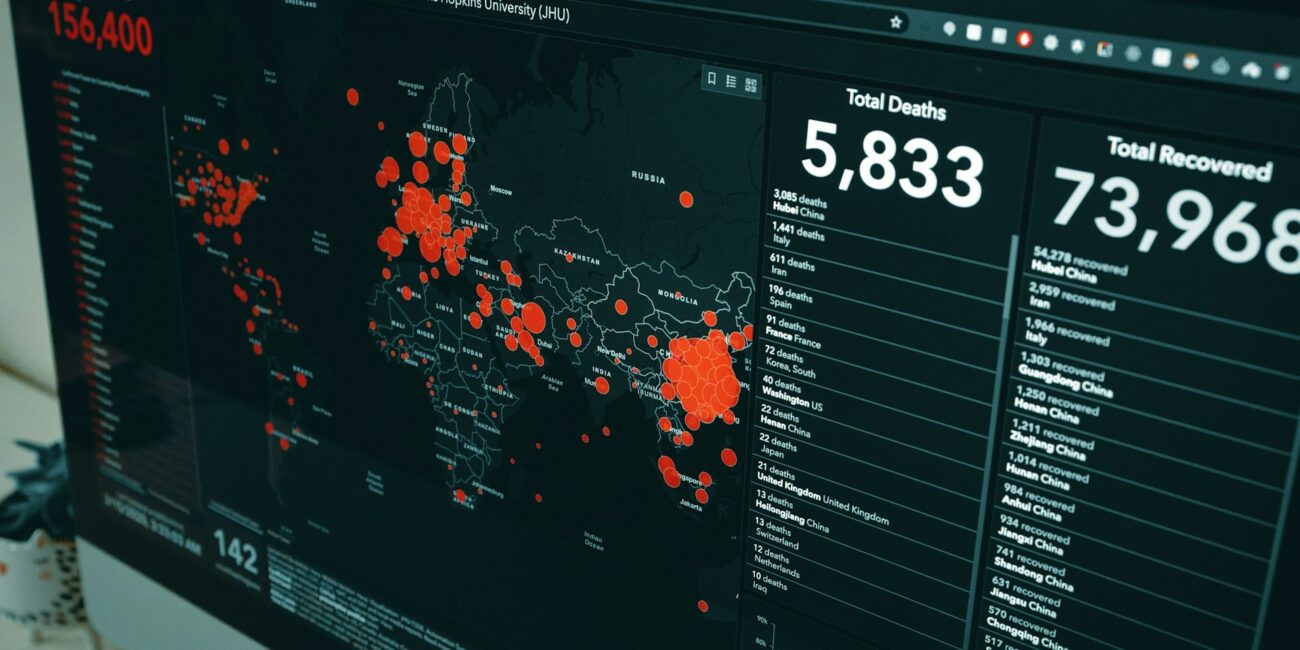To the Editor of The Lancet
On June 23, 2022, the journal Lancet Infectious Diseases published an article by Watson et al. entitled Global Impact of the first year of COVID-19 vaccination: a mathematical modelling study.[1] The authors of this paper “estimated that vaccinations prevented 14.4 million deaths from COVID-19 in 185 countries and territories between Dec 8, 2020 and Dec 8, 2021.” This estimate is so impossibly high that this article should be retracted by The Lancet. The obvious impossibility of their estimate may be demonstrated by any of the following five relatively simple calculations.
First, the WHO reports that as of Feb 17, 2023 there were “756.5 million confirmed cases of COVID-19 including 6.84 million deaths.”[2] This gives an overall case fatality rate (CFR) of 0.9%. At this rate, had the Covid vaccines prevented 14.4 million deaths in the space of one year, then they would also have needed to prevent 1.59 billion confirmed cases in that same year. But this is more than twice the total number of cases in three years, meaning it would require a six-fold increase in the number of confirmed cases since the beginning of the Covid era. Therefore, based on the overall CFR it is impossible that the vaccines saved 14.4 million deaths.
The situation is unchanged if we use data from before the vaccines were rolled out. The WHO reports that on December 28, 2020 there had been 84.9 million cases and 2.0 million deaths. This gives a CFR of 2.4%. To save 14.4 million deaths at this rate would require preventing 611 million cases, meaning it would require a 7 fold increase in infections and deaths in 2021 from Covid.
Second, it is well established that the infection fatality rate (IFR) of Covid is age-dependent. For instance, the BMJ published an article on Oct 26, 2020 which noted that “the US Centres for Disease Control and Prevention has said that eight in 10 Covid-19 related deaths reported in the country have been among people aged 65 years or over.”[3] Therefore, for vaccinations to have prevented 14.4 million deaths, they would need to have prevented 11.52 million deaths among those over 65 years of age. According to the UN, the world population is about 7,954 million, of which about 10% are over 65.[4] That means that there are 795 million people in this age group. To have prevented 11.52 million of them from dying would have required the following things to have happened during that one year:
- All 795 million people over 65 are vaccinated,
- None of these people contracted Covid while waiting to be (fully) vaccinated.
- The vaccines are 100% effective (absolute risk reduction) against death,
- Without vaccination, all 795 million would have contracted Covid, and
- The average IFR of Covid for those over 65 and unvaccinated is at least 1.45%.
In an earlier article in The Lancet it was estimated that the IFR of Covid (before vaccination) for those over 60 is 1.0035%.[5] Thus, all five of these requirements are either incorrect or impossible. Therefore based on age-specific mortality rates it is impossible that the vaccines prevented 14.4 million deaths.
Third, on Mar 10, 2022, The Lancet published an article in which it was estimated that between Jan 1, 2020 and Dec 31, 2021 about “18.2 million people died worldwide because of the COVID-19 pandemic.”[6] If the vaccines had successfully prevented another 14.4 million deaths, then 32.6 million deaths would have occurred without the vaccines. For this many people to have died, it would have required all eight billion people in the world to have been infected with Covid, and a global average IFR of at least 0.41%. But a bulletin published by WHO estimates the IFR to be at most 0.23%, and it “might even be substantially lower than 0.23%.”[7] One must conclude from this that either the Lancet article claiming 18.2 million people died in the first two years of Covid is incorrect, or the Lancet article claiming that 14.4 million deaths were prevented in the first year of the vaccines is incorrect, or both Lancet articles are incorrect. Therefore, based on published average IFRs, it is impossible that both Lancet articles are correct.
Fourth, on Jan 25, 2023, the UK Health Security Agency (UKHSA) published a report that estimated the number needed to vaccinate (NNV) to prevent a Covid hospitalisation. In Table 4 of Appendix 1, they say that 2,500 people over 70 must be vaccinated to prevent one severe hospitalisation in that age group.[8] This is the smallest NNV figure in the table. If we apply this number to the entire world population, and assume both that the entire population is over 70 years of age and that every last soul was vaccinated, according to the UKHSA data, only 3.2 million severe hospitalisations would be prevented. Therefore, it is clearly impossible for the vaccines to have prevented 14.4 million deaths.
Fifth, according to the published results of Pfizer’s Phase 3 clinical trials, of the 21,728 volunteers who received the placebo shot, 162 contracted Covid. Conversely, of the 21,720 volunteers who received the BNT162b2 injection, eight contracted Covid.[9] This means that the Pfizer shot may have prevented about 154 infections per 21,720 persons receiving the vaccine. According to Our-World-In-Data, about 4.5 billion people received at least one dose of a Covid vaccine during the first year of the roll-out.[10] Although not all received the Pfizer product, the majority did in many countries, and the Pfizer shot is generally held as the superior option. Thus, using Pfizer’s own results, at most 31.9 million infections might have been prevented in the first year of the vaccines. Using the IFR of 0.23% mentioned earlier, the maximum number of deaths prevented by the vaccines after one year is 73,384. This is almost 200 times less than the 14.4 million estimate put forward in the Lancet article.
It may be worthwhile to point out that Watson et al. inadvertently provide at least some of the reasons why their estimate is so obviously incorrect. In the first place, the authors expressly state that “excess all-cause mortality … [was] used to quantify the impact of the COVID-19 pandemic.” However, so many health variables were altered in 2020 and 2021 that it is certain that multiple factors contributed to excess mortality, not just Covid. Thus, they overestimated how lethal Covid was. And secondly, the authors testified that they assumed the vaccines were effective: “Vaccination was assumed to confer protection against SARS-CoV-2 infection and the development of severe disease requiring hospital admission, and to reduce transmission from vaccine breakthrough infections (i.e. we assumed vaccinated individuals who develop infection would be less infectious than unvaccinated individuals).” Since all of these assumptions are false (as Pfizer’s own clinical trial results testify), it is certain they overestimated the effectiveness of the vaccines.[11, 12, 13, 14, 15, 16]
In conclusion, by overestimating the mortality caused by Covid, and by overestimating how effective the vaccines were, Watson et al. came up with obviously incorrect conclusions about how many deaths were prevented by the Covid vaccines. Whether one looks at the average CFR, or the age-specific IFR, or the average IFR, or the NNV, or Pfizer’s own data, it is quite impossible that the Covid vaccines prevented 14.4 million deaths in the first year. Since this is a tremendously important issue to society at large, it is requested that the editors at The Lancet retract this obviously flawed paper.
PANDA
References
- Watson, Oliver, et al, “Global impact of the first year of COVID-19 vaccination: a mathematical modelling study,” June 23, 2022 DOI:https://doi.org/10.1016/S1473-3099(22)00320-6
- Anonymous, “WHO Coronavirus (COVID-19) Dashboard,” World Health Organization, 2023, https://covid19.who.int/
- Mahase E. “Covid-19: Why are age and obesity risk factors for serious disease?” BMJ 2020; 371 :m4130 doi:10.1136/bmj.m4130
- Anonymous, “World Population Dashboard,” United Nations Population Fund, 2023, https://www.unfpa.org/data/world-population-dashboard
- Covid-19 Forecasting Team, “Variation in the COVID-19 infection–fatality ratio by age, time, and geography during the pre-vaccine era: a systematic analysis,” February 24, 2022 DOI: https://doi.org/10.1016/S0140-6736(21)02867-1
- Wang, Haidong, “Estimating excess mortality due to the COVID-19 pandemic: a systematic analysis of COVID-19-related mortality, 2020–21,” March 10, 2022 DOI: https://doi.org/10.1016/S0140-6736(21)02796-3
- Ioannidis, John P A. (2021). Infection fatality rate of COVID-19 inferred from seroprevalence data. Bulletin of the World Health Organization, 99 (1), 19 – 33F. World Health Organization. http://dx.doi.org/10.2471/BLT.20.265892
- Anonymous, “Appendix 1: estimation of number needed to vaccinate to prevent a COVID-19 hospitalisation for primary vaccination, booster vaccination (3rd dose), autumn 2022 and spring 2023 booster for those newly in a risk group,” 2023, UKHSA, https://assets.publishing.service.gov.uk/government/uploads/system/uploads/attachment_data/file/1131409/appendix-1-of-jcvi-statement-on-2023-covid-19-vaccination-programme-8-november-2022.pdf
- Polack, Fernando et al, “Safety and Efficacy of the BNT162b2 mRNA Covid-19 Vaccine,” December 31, 2020 N Engl J Med 2020; 383:2603-2615 DOI: 10.1056/NEJMoa2034577
- Anonymous, “Number of people vaccinated against COVID-19, World, Dec 30, 2021,” Our World in Data, 2023, COVID-19 Data Explorer – Our World in Data
- Pritchard et al, “Impact of vaccination on SARS-CoV-2 cases in the community: a population-based study using the UK’s COVID-19 Infection Survey,” medRxiv 2021.04.22.21255913; doi: https://doi.org/10.1101/2021.04.22.21255913
- Centers for Disease Control and Prevention, USA, “Rates of Covid-19 Cases and Deaths by Vaccination Status,” 2022, https://covid.cdc.gov/covid-data-tracker/#rates-by-vaccine-status
- Yasmin Tayag, “Why has the CDC stopped collecting data on breakthrough Covid cases?,” 2021, The Guardian, https://www.theguardian.com/commentisfree/2021/aug/06/cdc-covid-coronavirus-data-breakthrough-cases
- Wang, Lindsey et al, “Increased risk for COVID-19 breakthrough infection in fully vaccinated patients with substance use disorders in the United States between December 2020 and August 2021,” Wiley Online Library, 2021, https://doi.org/10.1002/wps.20921
- Marking, Ulrika et al, “High rate of BA.1, BA.1.1 and BA.2 infection in triple vaccinated,” medRxiv 2022.04.02.22273333; doi: https://doi.org/10.1101/2022.04.02.22273333
- Pfizer confidential data released by FOIA, “Cumulative Analysis of Post-Authorization Adverse Event Reports of PF-07302048 (BNT162B2) Received Through 28-Feb-2021,” 2021, https://www.scribd.com/document/543857539/CUMULATIVE-ANALYSIS-OF-POST-AUTHORIZATION-ADVERSE-EVENT-REPORTS-OF-PF-07302048-BNT162B2-RECEIVED-THROUGH-28-FEB-2021#
Thomas Verduyn has an honors B.A.Sc in aerospace engineering. He has a wide range of work experiences including computer consulting, construction, transportation, accounting, and entrepreneurship. He is an avid reader of many different fields. He has published multiple books, is keenly interested in health, and is passionate about knowing God.




